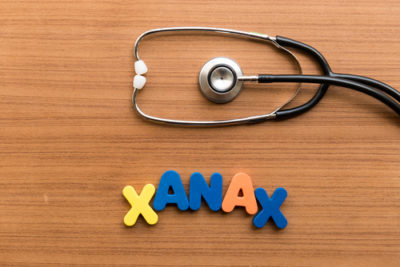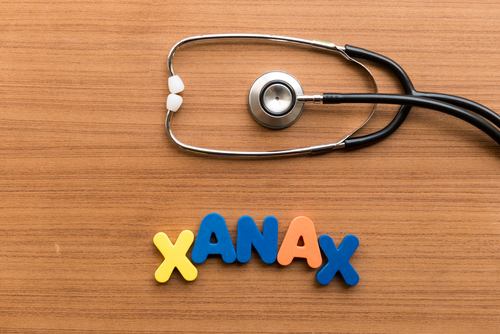Why Do People Take Xanax and Why Do People Abuse Xanax?

WHAT IS XANAX?
Xanax is the brand name of alprazolam, a prescription medication in the drug class of benzodiazepines. The medication targets brain chemicals that may be out of balance in those who suffer from anxiety. The brain chemical (GABA) works to create a calming effect.
WHAT CONDITIONS DOES XANAX TREAT?
Xanax is prescribed to treat anxiety disorders (specifically, generalized anxiety disorder), anxiety caused by depression, and panic disorders, according to Drugs.com. Other purposes for which Xanax may be used include treatment of agoraphobia. Off-label uses for Xanax include treating insomnia, agitation, and premenstrual dysphoric disorder (PDD).
WHAT ARE THE SIDE EFFECTS OF XANAX USE?
When taking Xanax, the user may have difficulty thinking and reacting. For this reason, doctors urge caution driving or performing anything that requires alertness while taking Xanax. It’s also very important to avoid drinking alcohol while taking Xanax, as the combination could cause dangerous side effects.
Grapefruit juice and grapefruit should also be avoided when taking this medication, since the alprazolam in Xanax can result in certain side effects.
One possible serious side effects of Xanax use is an allergic reaction, difficulty breathing, hives, swelling of the face, lips, tongue or throat. When an allergic reaction occurs after taking Xanax, summon emergency medical help right away.
Those prescribed Xanax should contact their doctor immediately if they experience any of the following:
- Agitation
- Confusion
- Depressed mood
- Fluttering in the chest, pounding heartbeat
- Hallucinations
- Hostility
- Increased energy
- Muscle movements that are uncontrolled
- Racing thoughts
- Risk-taking behavior that is unusual
- Thoughts of suicide or self-harm
Common Xanax side effects to be aware of include early morning anxiousness, balance or coordination loss, drowsiness, fatigue, memory problems, or slurred speech.
WHAT ARE THE POSSIBLE DRUG INTERACTIONS WITH XANAX USE?
Xanax taken with certain other drugs that cause sleepiness or slow the breathing can produce side effects that are dangerous, and may even lead to death. For this reason, do not take Xanax when you’re also prescribed medications for muscle relaxers, sleeping, narcotic pain relievers, prescription cough medicine, or medications you take for anxiety, depression, or seizures. While these other medications may have preceded Xanax prescribing, talk with your doctor about all the medications you currently take, so precautions can be taken to avoid possible drug interactions.
Other drugs that may interfere with alprazolam include antihistamines, antifungal medication, HIV/AIDS medications, and over-the-counter vitamins and herbal products, among others.
HOW IS XANAX ABUSED?
Like opiates, Xanax and other benzodiazepines work on the central nervous system. They are both depressants that slow heart rate, creating a feeling of relaxation, and reducing stress (physical and emotional). The well-being that Xanax and opiates produce is the result of endorphins being released.
The more Xanax a user takes, and the more frequently the drug is taken, contributes to increased tolerance – the need to take more of the drug, more often, just to achieve the same effects. After tolerance, dependence occurs, which is the body’s physical need for the drug in order to function.
Adjusting to ever higher levels of Xanax intoxication compels the user to up doses, which can bring about further negative consequences, including addiction.
Ways People Abuse Xanax
In an effort to enhance the effects of the medication, Xanax abusers often crush the pills and snort them. They may use a makeshift straw (the slang term for this is “tooter”) or a device that crushes pills.
WHY IS XANAX ABUSED?
In a high-stress world, people may seek various means of escaping reality, forgetting about their troubles, taking a break from responsibilities, numbing pain and distressing emotions. Frequently, this takes the form of drug and alcohol use.
Some say taking drugs like Xanax makes them feel sexy, while others say they like how it makes them feel calm and docile.
Another increasingly common trend is that some abusers of Xanax also abuse opiates, both prescription and illicit. They may have started combining the two in an attempt to make the feeling of euphoria from the opiate greater, or to produce a longer-lasting numbing effect.
Unfortunately, combining Xanax and opiates can intensify the effects (and side effects) of both substances, often in highly unpredictable ways. Even someone who is a regular user of prescription Xanax can suffer negative consequences when adding the medication to a new or continuing use of opiates.
Anecdotal reports of why people abuse Xanax generally relate that the drift from use to abuse is often unintentional. A case in point involves a personal story published in Medical News Today by one man who said his extreme anxiety and pain caused him to seek medical help, after which doctor(s) prescribed a Xanax and oxycodone for the conditions, respectively. Finally, his terrors and pain ceased, but this was not to last. His daily use became twice, then multiple times per day, eventually becoming nonstop throughout the day. More than dependent, he had become addicted. It took more time (and more doctor-shopping for pills) before he finally went into detox and treatment. Learning healthier behaviors, joining support groups, going to individual and group counseling did help him overcome both addictions. He says he still has some anxiety, and admits he still craves the high, but he’s able to live his life with the tools he’s learned, and isn’t a slave to pills.
A medical doctor writing a post appearing in Psychology Today talked about a patient of his who had been prescribed Xanax for insomnia, and subsequently was unable to stop taking the drug. Indeed, Xanax and other benzodiazepines are the most commonly prescribed drugs worldwide. People take them for any number of reasons, and often don’t need them at all, yet they continue to take them, “just in case.”
WHAT IS THE WORST THAT CAN HAPPEN WITH XANAX ABUSE?
Taking too much Xanax, especially in combination with alcohol and other medications, especially opiate pain relievers, can prove deadly. The heart can stop, the abuser may suffer seizures, go into a coma, or die.
Abusing Xanax can dramatically alter a person’s motor skills, which may result in frequent falls or stumbling into objects. Xanax abuse is also associated with memory loss, blackouts, not remembering what happened before the drug wore off. Decrease of inhibition is highly characteristic of Xanax abuse, and is part of its allure for many who take the drug to overcome shyness or to quell the self-censor so they can have a good time without worrying about consequences. As a result of a lowering of inhibitions, Xanax abusers may engage in risky behavior, making spur-of-the-moment decisions that are not well thought out.
Xanax Withdrawal
Withdrawal reactions can occur when someone who takes Xanax suddenly stops taking it. Abruptly discontinuing the medication can cause seizures. If the intent is to cease taking Xanax, it’s important to work with the doctor to gradually reduce the doses, so withdrawal symptoms can be avoided.
can include anxiety, confusion, insomnia, irritability, and sweating, among others. Symptoms usually start to kick in 2-7 days after the last Xanax dose and can last between 2-8 weeks.
Xanax Addiction
Addiction is another concern, particularly among those who have been taking Xanax for a long time. This risk is elevated in those who may also have a substance use disorder (SUD), or alcohol use disorder (AUD). Once Xanax abuse crosses over to addiction, only medically-supervised detox and treatment can help restore normal functioning. Polydrug addiction (addiction to multiple drugs and/or alcohol) coinciding with may require longer treatment to overcome.
According to the 2017 National Survey on Drug Use and Health, an estimated 739,000 people had tranquilizer use disorder in 2017. Benzodiazepines like Xanax are tranquilizers, a highly-addictive class of drug. As for current tranquilizer misuse in the U.S., the NSDUH estimates that 1.7 million people misused the drug in 2017.
CAN YOU OVERDOSE ON XANAX?
When taken as prescribed and exactly as directed by a physician, Xanax should not cause overdose. However, when someone takes more of Xanax that called for, overdose can occur, leading to coma or death.
Xanax overdose symptoms may include:
- Confusion
- Extreme dizziness
- Fainting
- Lightheadedness
- Loss of coordination, loss of balance
- Muscle weakness
A report from the Centers for Disease Control and Prevention (CDC) published in January 2019 shows that overdose deaths involving benzodiazepines among middle-aged women increased 830 percent from 1999-2017.
TREATMENT FOR XANAX ADDICTION
There is a way out of the nightmare of , and it involves detoxing from the substance, entering Florida inpatient treatment or outpatient treatment that combines counseling, behavioral therapies, relaxation techniques, support groups and more. Co-occurring (dual diagnosis treatment) prescription drug addiction and mental health disorders, such as anxiety disorder, can also be successfully treated, as can polydrug addiction.
If you know someone who’s hooked on Xanax and quite possibly in denial about how much their life has changed for the worse as a result, or if you are experiencing negative consequences due to Xanax abuse yourself, look into how can help. It may not be the easiest thing you’ve ever done, but it will be the most life-affirming. The most important thing to remember is that you don’t need to go through life suffering. There are alternatives to pills to get your life back. Furthermore, with therapy you can overcome the self-doubt, anxious thoughts, and constant fear of failure to measure up and begin to enjoy life as you’re meant to.
For more about Xanax abuse, addiction and recovery, check out these articles:
5 of the Best Ways to Treat Anxiety Disorder
How Long Does It Take to Get Addicted to Xanax?
Xanax Detox: Withdrawal Symptoms and Timeline
Xanax Withdrawal Timeline – Common Symptoms to Expect During Early Recovery

